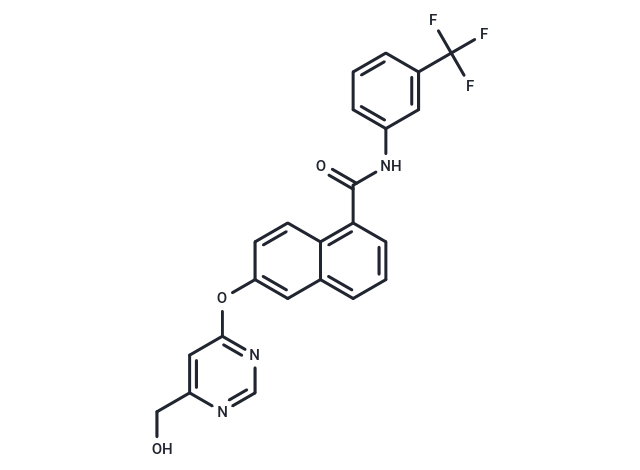Shopping Cart
- Remove All
 Your shopping cart is currently empty
Your shopping cart is currently empty

BFH772, a structure analogue of BAW2881, is a potent and selective VEGF inhibitor. BFH772 is highly effective at targeting VEGFR2 kinase with an IC50 value of 3 nM. BFH772 inhibits the ligand induced autophosphorylation of RET, PDGFR, and KIT kinases, with IC50 values ranging between 30 and 160 nM.

| Pack Size | Price | Availability | Quantity |
|---|---|---|---|
| 2 mg | $38 | In Stock | |
| 5 mg | $60 | In Stock | |
| 10 mg | $105 | In Stock | |
| 25 mg | $198 | In Stock | |
| 50 mg | $297 | In Stock | |
| 100 mg | $563 | In Stock | |
| 1 mL x 10 mM (in DMSO) | $67 | In Stock |
| Description | BFH772, a structure analogue of BAW2881, is a potent and selective VEGF inhibitor. BFH772 is highly effective at targeting VEGFR2 kinase with an IC50 value of 3 nM. BFH772 inhibits the ligand induced autophosphorylation of RET, PDGFR, and KIT kinases, wit |
| Targets&IC50 | VEGFR2:3 nM |
| In vitro | Daily oral administration of 3 mg/kg BFH772 effectively inhibits melanoma growth, with primary tumors reducing by 54-90% and metastatic tumors diminishing by 71-96%. |
| In vivo | BFH772 inhibits ligand-induced autophosphorylation of RET, PDGFR, and KIT kinases with an IC50 (half maximal inhibitory concentration) value of 30-160 nM. It effectively targets VEGFR2 with an IC50 of 3 nM, demonstrating efficacy 500 times lower against FLK-1, FLT-1, and FLT-4 compared to VEGFR2. Beyond VEGFR2, BFH772 also targets B-RAF, RET, and TIE-2, albeit with over 40 times lower efficacy compared to its action on VEGFR2. |
| Kinase Assay | In vitro kinase assay is based on a filter binding assay, using the recombinant GST-fused kinase domains expressed in baculovirus and purified over glutathione-sepharose, γ-[33P]ATP as the phosphate donor, and poly(Glu:Tyr 4:1) peptide as the acceptor. Each GST-fused kinase is incubated under optimized buffer conditions [20 mM Tris-HCl buffer (pH 7.5), 1-3 mM MnCl2, 3-10 mM MgCl2, 3-8 μg/mL poly(Glu:Tyr 4:1), 0.25 mg/mL polyethylene glycol 20000, 8 μM ATP, 10 μM sodium vanadate, 1 mM DTT] and 0.2 μCi γ-33P ATP in a total volume of 30 μL in the presence or absence of a test substance for 10 min at ambient temperature. The reaction is stopped by adding 10 mL of 250 mM EDTA. Using a 384-well filter system, half the volume is transferred onto an Immobilon-polyvinylidene difluoride membrane. The membrane is then washed extensively and dried, and scintillation counting is performed. IC50s for compounds are calculated by linear regression analysis of the percentage inhibition[1]. |
| Cell Research | Subconfluent HUVECs were incubated in triplicate in 96-well plates with basal medium containing 1.5% FCS and a constant concentration of VEGF (10 ng/mL), bFGF (0.5 ng/mL), or FCS (5%) in the presence or absence of compounds. After 24 h of incubation, BrdUrd labeling solution was added and cells incubated an additional 24 h before fixation, blocking, and addition of peroxidaselabeled anti-BrdUrd antibody. Bound antibody was then detected spectrophotometrically at 450 nm.(Only for Reference) |
| Alias | BFH-722 |
| Molecular Weight | 439.39 |
| Formula | C23H16F3N3O3 |
| Cas No. | 890128-81-1 |
| Smiles | OCc1cc(Oc2ccc3c(cccc3c2)C(=O)Nc2cccc(c2)C(F)(F)F)ncn1 |
| Relative Density. | 1.432 g/cm3 (Predicted) |
| Storage | Powder: -20°C for 3 years | In solvent: -80°C for 1 year | Shipping with blue ice. | |||||||||||||||||||||||||||||||||||
| Solubility Information | Ethanol: 81 mg/mL (184.35 mM), Sonication is recommended. H2O: < 1 mg/mL (insoluble or slightly soluble) DMSO: 81 mg/mL (184.35 mM), Sonication is recommended. | |||||||||||||||||||||||||||||||||||
Solution Preparation Table | ||||||||||||||||||||||||||||||||||||
Ethanol/DMSO
| ||||||||||||||||||||||||||||||||||||

Copyright © 2015-2025 TargetMol Chemicals Inc. All Rights Reserved.